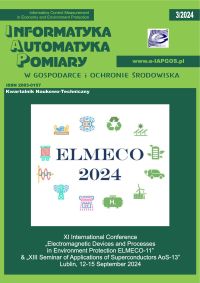MODELOWANIE URZĄDZEŃ SPINTRONICZNYCH DO ZASTOSOWANIA W PAMIĘCI O DOSTĘPIE SWOBODNYM RAM
Ruslan Politanskyi
r.politansky@chnu.edu.uaLviv Polytechnic National University (Ukraina)
Maria Vistak
Danylo Halytsky Lviv National Medical University, Faculty of Pharmacy, Department of Biophysics (Ukraina)
http://orcid.org/0000-0001-5192-4017
Andriy Veryga
Yuriy Fedkovych Chernivtsi National University, Physical, Technical and Computer Sciences Institute, Department of Radio Engineering and Information Security (Ukraina)
http://orcid.org/0000-0002-2616-3057
Tetyana Ruda
Yuriy Fedkovych Chernivtsi National University, Physical, Technical and Computer Sciences Institute, Department of Radio Engineering and Information Security (Ukraina)
http://orcid.org/0000-0002-0008-9362
Abstrakt
W tym artykule analizowane są procesy fizyczne zachodzące w strukturach zaworów spinowych podczas procesu rejestrowania informacji, który występuje w urządzeniach z szybką pamięcią magnetyczną. Obiektem badań są urządzenia wykorzystujące magnetyzację warstwy ferromagnetycznej poprzez przenoszenie momentu magnetycznego za pomocą spolaryzowanego spinu (STT-MRAM). Wyprowadzono podstawowe równania potrzebne do modelowania procesu rejestrowania informacji w modelu symetrycznego kanału binarnego. W związku z tym, że prawdopodobieństwo błędu wynika z procesu magnesowania, stworzony jest model procesu magnesowania, który został wyprowadzony z równań Landaua-Lifshitza-Hilberta przy założeniu magnesu jednodomenowego. Wybór modelu jednodomenowego wynika z nanometrycznej wielkości płaskiej warstwy magnetycznej. Opracowana metoda modelowania procesu rejestrowania informacji określa zależność wskaźników, takich jak prawdopodobieństwo błędnego bitu i szybkość transmisji informacji, od dwóch ważnych właściwości procesu rejestrowania: natężenia prądu i czasu jego trwania. Końcowym rezultatem i zarazem celem symulacji jest określenie optymalnych wartości natężenia prądu i czasu trwania rejestracji informacji, przy których prędkość procesu zapisu będzie najwyższa dla danego stopnia prawdopodobieństwa błędu. Uzyskano wartości liczbowe dla szybkości transmisji i prawdopodobieństwa błędu dla szerokiego zakresu natężenia prądu (10–1500 μA) i czasu rejestracji jednego bitu (1–70 ns), które ogólnie poprawnie opisują proces transmisji informacji. Wyniki obliczeń zostały porównane ze specyfikacją techniczną istniejących urządzeń przemysłowych i urządzeń będących obiektami badań naukowych. Powstały model można wykorzystać do symulacji urządzeń wykorzystujących różne wartości natężenia prądu: układy szeregowe STT-MRAM wykorzystujące niskie natężenie prądu (500–100 μA), urządzenia na etapie projektowania technologicznego, które wykorzystują średnie natężenie prądu (100–500 μA) oraz urządzenia będące obiektami eksperymentalnych badań naukowych, które wykorzystują wysokie natężenie prądu (500–1000 μA). Model można również zastosować w symulacjach urządzeń o różnych szybkościach transmisji danych, które mają różne wymagania dotyczące zarówno szybkości transmisji, jak i prawdopodobieństwa błędu w jednym bicie informacji. W ten sposób model ten można wykorzystać zarówno w urządzeniach z szybką pamięcią w systemach komputerowych, jak i w czujnikach sygnałów, które są podłączone do sieci czujników lub podłączone do Internetu rzeczy.
Słowa kluczowe:
STT-MRAM, prąd spolaryzowany spinowo, symetryczny kanał binarnyBibliografia
Alioto M.: STT-MRAM memories for IoT applications. Challenges and opportunities at circuit level and above International Symposium on VLSI Technology, Systems and Application VLSI-TS, Hsinchu, 2017, [http://doi.org/10.1109/VLSI-TSA.2017.7942448].
DOI: https://doi.org/10.1109/VLSI-TSA.2017.7942448
Google Scholar
Apalkov D., Dieny B., Slaughter J.: Magnetoresistive Random Access memory. Proc. of the IEEE 109/2017, 1796–1830, [http://doi.org/10.1109/JPROC.2016.2590142].
DOI: https://doi.org/10.1109/JPROC.2016.2590142
Google Scholar
Bhatti S. et al.: Spintronic based random access memory: a review. Materials Today 6(9)/2017, 530–548, [http://doi.org/10.1016/j.mattod.2017.07.007].
DOI: https://doi.org/10.1016/j.mattod.2017.07.007
Google Scholar
Cai K., Immink K. A. S.: Cascaded channel modeling, analysis, and hybrid decoding for spin-torque transfer magnetic random access memory. IEEE Transactions on Magnetics 53(11)/2017, 1–11, [http://doi.org/10.1109/TMAG.2017.2711245].
DOI: https://doi.org/10.1109/TMAG.2017.2711245
Google Scholar
Cai H.: High performance MRAM with spin-transfer-torque and voltage-controlled magnetic anisotropy effects. Applied Sciences 7(9)/2017, 929–943, [http://doi.org/10.3390/app7090929].
DOI: https://doi.org/10.3390/app7090929
Google Scholar
Chung S. et al.: 4Gbit Density STT-MRAM using Perpendicular MTJ Realized with Compact Cell Structure IEEE International Electron Devices Meeting IEDM, San Francisco 2016, [http://doi.org/10.1109/IEDM.2016.7838490].
DOI: https://doi.org/10.1109/IEDM.2016.7838490
Google Scholar
Greenan K., Miller E.: Reliability mechanisms for file systems using non-volatile memory as a metadata store. International conference on Embedded software EMSOFT, Seoul 2006, [http://doi.org/10.1145/1176887.1176913].
DOI: https://doi.org/10.1145/1176887.1176913
Google Scholar
Lai H. et al.: STT-MRAM application on IoT data privacy protection system. IEEE International Conference on Consumer Electronics ICCE-TW, Taichung 2018, [http://doi.org/10.1109/ICCE-China.2018.8448476].
Google Scholar
Lee K.: Bit error rate engineering for spin-transfer-torque MRAM. International Integrated Reliability Workshop. International IEEE Conference, South Lake Tahoe 2014, [http://doi.org/10.1109/IIRW.2014.7049540].
Google Scholar
Lee Y. et al.: Embedded STT-MRAM in28-nm FDSOI Logic Process for Industrial MCU/IoT Application. IEEE Symposium on VLSI Technology, Honolulu 2018, [http://doi.org/10.1109/VLSIT.2018.8510623].
DOI: https://doi.org/10.1109/VLSIT.2018.8510623
Google Scholar
Sun J.Z., Xu, Y.: Handbook of Spintronics. Springer, Chicago 2016.
Google Scholar
Sverdlov V., Makarov A.,Selberherr S.: Switching current reduction in advanced spin-orbit torque MRAM. Joint International EUROSOI Workshop and International Conference on Ultimate Integration on Silicon EUROSOL-ULIS, 2018, [http://doi.org/10.1109/ULIS.2018.8354759].
DOI: https://doi.org/10.1109/ULIS.2018.8354759
Google Scholar
Vatajelu E. et al.: STT MRAM-Based PUF’s. Design, Automation & Test in Europe Conference & Exhibition DATE, Grenoble 2015, [http://doi.org/10.7873/DATE.2015.0505].
DOI: https://doi.org/10.7873/DATE.2015.0505
Google Scholar
Wang P. et al.: Development of STT-MRAM for embedded memory applications. IEEE International Magnetic Conference INTERMAG, Dublin 2017, [http://doi.org/10.1109/INTMAG.2017.8007930].
DOI: https://doi.org/10.1109/INTMAG.2017.8007930
Google Scholar
Yamauchi T.: Prospect of embedded non-volatile memory in the smart society. VLSI Technology, System and Application: International Symposium, Hsinchu 2015, [http://doi.org/10.1109/VLSI-TSA.2015.7117541].
DOI: https://doi.org/10.1109/VLSI-TSA.2015.7117541
Google Scholar
Autorzy
Maria VistakDanylo Halytsky Lviv National Medical University, Faculty of Pharmacy, Department of Biophysics Ukraina
http://orcid.org/0000-0001-5192-4017
Autorzy
Andriy VerygaYuriy Fedkovych Chernivtsi National University, Physical, Technical and Computer Sciences Institute, Department of Radio Engineering and Information Security Ukraina
http://orcid.org/0000-0002-2616-3057
Autorzy
Tetyana RudaYuriy Fedkovych Chernivtsi National University, Physical, Technical and Computer Sciences Institute, Department of Radio Engineering and Information Security Ukraina
http://orcid.org/0000-0002-0008-9362
Statystyki
Abstract views: 406PDF downloads: 9320
Licencja

Utwór dostępny jest na licencji Creative Commons Uznanie autorstwa – Na tych samych warunkach 4.0 Miedzynarodowe.
Inne teksty tego samego autora
- Ruslan Politanskyi, Andrij Veryga, URZĄDZENIE PRZEŁĄCZAJĄCE INTERWAŁ CZASOWY , Informatyka, Automatyka, Pomiary w Gospodarce i Ochronie Środowiska: Tom 10 Nr 1 (2020)
- Ruslan Politanskyi, Andrij Veryga, ANALIZA CHARAKTERYSTYK KORELACYJNYCH I SPEKTRALNYCH SYGNAŁÓW FRAKTALNYCH O STRUKTURZE GRZEBIENIOWEJ , Informatyka, Automatyka, Pomiary w Gospodarce i Ochronie Środowiska: Tom 6 Nr 1 (2016)








